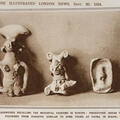Steatite Disc Beads
This set of steatite disc beads found at Harappa, each about 1 cm in diameter, were found in a Kot Diji phase (ca. 2800-2600 BCE) street and appear to be a necklace segment that was lost in the trash. The manufacturing marks are clearly visible. The matched nature of the beads suggests that a preform of raw steatite was shaped, drilled with a copper tube, and subsequently sewn into segments.










